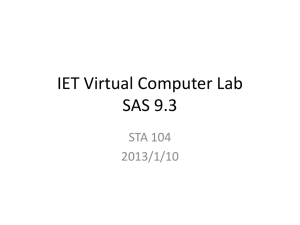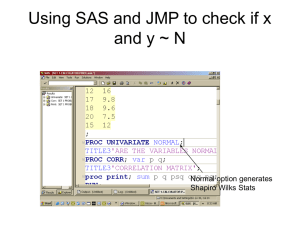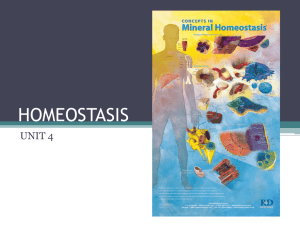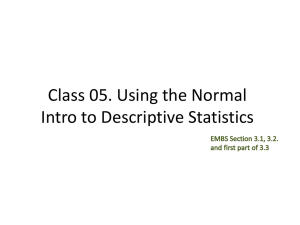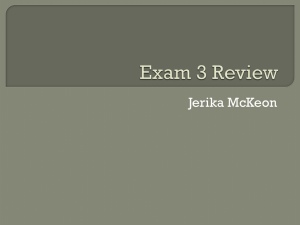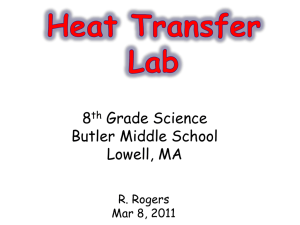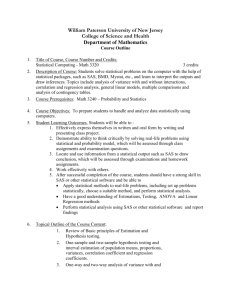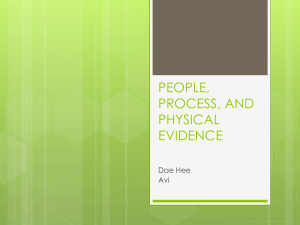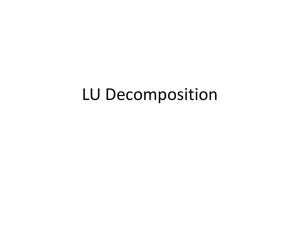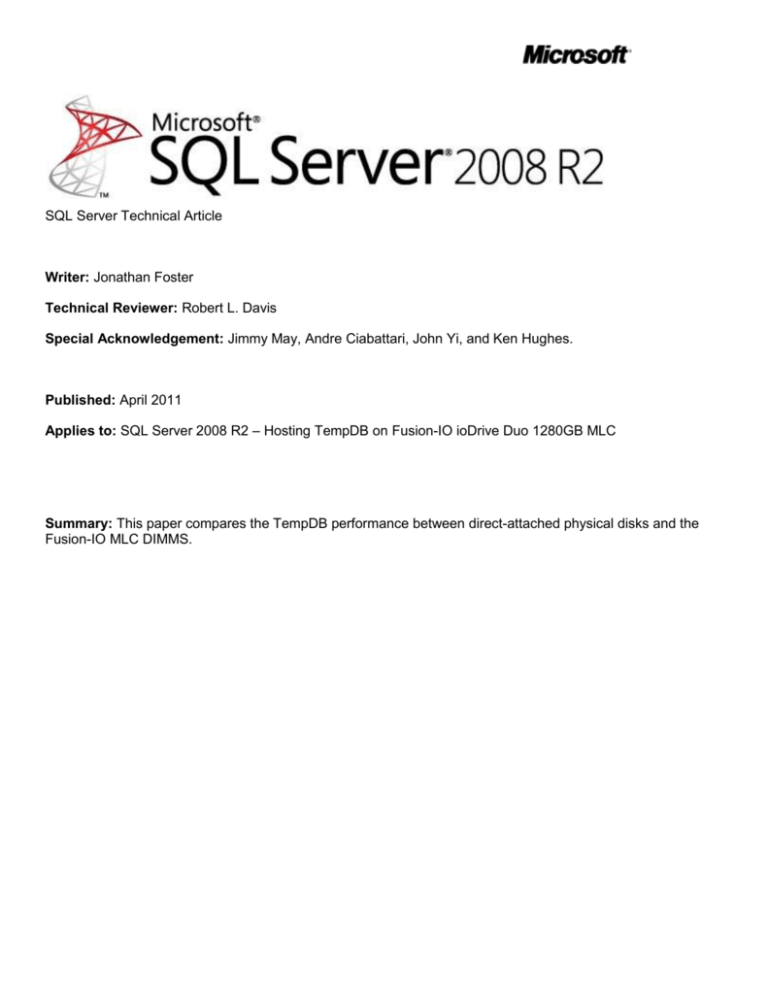
SQL Server Technical Article
Writer: Jonathan Foster
Technical Reviewer: Robert L. Davis
Special Acknowledgement: Jimmy May, Andre Ciabattari, John Yi, and Ken Hughes.
Published: April 2011
Applies to: SQL Server 2008 R2 – Hosting TempDB on Fusion-IO ioDrive Duo 1280GB MLC
Summary: This paper compares the TempDB performance between direct-attached physical disks and the
Fusion-IO MLC DIMMS.
Copyright
This document is provided “as-is”. Information and views expressed in this document, including URL and other Internet
Web site references, may change without notice. You bear the risk of using it.
This document does not provide you with any legal rights to any intellectual property in any Microsoft product. You may
copy and use this document for your internal, reference purposes.
© 2011 Microsoft. All rights reserved.
2
Introduction
The Product Quality & Online group (PQO) at Microsoft was asked to design a centralized data store hosting
copies of all the OLTP and data warehouses managed by their parent group, Customer Service & Support
(CSS). While the long-term plan is a scale-out approach using Parallel Data Warehousing (PDW), the shortterm plan is a scale-up approach based on the familiar star schema where several individual servers running
ETL’s and replication publications feed one very powerful server (VPS) that presents all the data to users. Due
to the ad hoc nature of the queries expected to be run on the VPS, the monthly increase of end-users, and the
need to actively manage maintenance tasks across 200+ databases, the designers were concerned about the
disk i/o performance of TempDB.
The main driving factor for a scale-up design was driven by end-user needs to perform cross-database
queries. Linked servers queries and distributed queries would not provide acceptable performance to end
users. A scale-up design was implemented in 2009 using an HPDL5-580 G5 w/ 24 CPU cores and 256GB
RAM. The server was attached to an EMC CX4-240 SAN with a mixture of Solid State (SSD), Fiber Channel
(FC), and SATA drives. Performance analysis revealed that TempDB accounted for approximately 30% of all
the I/O on the server on any given day. For this reason, the TempDB was hosted on 2 LUNs spread across 48
72GB SAS 15k drives that were direct-attached to the server. At an estimate of 180 IOPS per disk this setup
provided approximately 5750 IOPS.
The size of the data being hosted and the number of users grew significantly in 2009/2010 which forced
another upgrade in 2011. The to-be presentation server is a HP5-DL580 G7 w/ 48 cores and 1TB of RAM. The
server was attached to an EMC CX4-960 SAN having a mixture of Solid State (SSD), Fiber Channel (FC), and
SATA drives. The new G7’s attached storage for hosting TempDB consists of 32 300GB SAS 10k disks. An
estimate of 140 IOPS per disk provides approximately 2770 IOPS for the entire LUN resulting in a 50%
throughput reduction from the G5 attached storage.
TempDB storage usage from 2009-2010 was typically 400GB per day with a maximum of 800GB. Performance
of TempDB on the G5 was very good with disk response times predominately in the 5ms-8ms range and an
average queue depth less than 1. The average daily load on TempDB physical disks by 80% of the users is
approximately 400 writes and 480 reads. The remaining 20% of the users produced an average daily load of
approximately 55400 writes and 85050 reads, and these users are the primary stakeholders of the data. The
number of primary stakeholders is expected to increase dramatically in the next 12 months as will the amount
of data they will be querying. For this reason it is imperative that the performance of TempDB be maintained at
least to current levels which eliminate the use of the G7 attached storage. Use of SAN storage to host
TempDB is not desired because the number of spindles required to provide the needed throughput results in a
significant amount of unused storage. Since the TempDB database accounts for over 20% of the I/O,
segregating that I/O off of the SAN heads helps reduce the overall load on the SAN as well.
Test Environment
Hardware
Platform
HP ProLiant SE326M1 2U SAS Model
CPU (Clock Speed, Cache, Max TDP)
2 x 8 Intel Xeon L5520 2.26GHz, 8MB L3 Cache, 60W
Memory
12 x 4GB PC3-10600R (48GB total)
HDDs (Capacity, Rotational Speed,
20 x 146GB 10K SAS 2.5” (T$) , 5 x 300GB 10K SAS
2.5”(H$)
2 x Fusion 640 ioDrive Duo cards (U$)
Interface, Form Factor)
ioDIMMS
LUN Configuration
3
LUN1 & LUN2 = 2x146GB RAID1 (OS & SQL)
LUN3 = 7x300GB RAID5 (SQL data and log files)
LUN4 = 16x146GB RAID10 (TempDB)
LUN5 = 2x640 MCL ioDimms RAID1 (TempDB)
Controller
HP P410/256 Smart Array Controller with Battery
Power Supply
2 x 750W Gold N+1 Redundant Power
Network
Single Dual Port Embedded Intel NIC
Storage Configuration
HDDs
Phase 1 ~ T$ = RAID1+0; H$ = RAID5
Phase 2 ~ T$ = RAID 0; H$ = RAID5
U$ = RAID 0
ioDimms
Software
OS
Windows Server 2008 R2 Enterprise
SQL
Microsoft SQL Server 2008 R2 (RTM) - 10.50.1600.1
(X64)
Test
The test will involve a variety of TempDB intensive queries executed concurrently via SSIS while capturing disk
performance counters to measure I/O throughput. The test will be executed 6 times against the same server: 3 runs with
TempDB hosted on SAS drives and 3 runs with TempDB hosted on the Fusion-IO drives.
Test Details
1) DDL Tasks
a. Analyze index fragmentation in a 1.25TB database having 1243 indexes in 436 tables (max
index size = 3530024kb and min index size = 16kb).
b. Reorganize all indexes found to have more than 10% and less than 30% fragmentation (est.
130 indexes at 5840KB)
i. Rebuild all indexes using the Sort in TempDB option that are found to have more than
29% fragmentation (est. 688 indexes at 56380144KB)
ii. Run DBCC CHECKTABLE on 11242382KB table
2) DML Tasks – (executed simultaneously with the above-mentioned DDL Tasks)
a. Create and populate 3 temp tables with 1247328KB each of sorted data including LOB data
types (all subsequent items are performed in 3 streams synchronously the only difference
being the WHERE qualifiers in the final queries)
4
i. Regular SELECTs and INSERTs:
1. Perform sorted distinct select of 2469264KB worth of data into user table
from each temp table.
2. Insert 4938528KB of data to new temp table using UNION ALL
3. Insert 4938528KB of data to new temp table
4. Insert 555375 KB of data to new temp table using sorted SUBSTRING
SELECT with WHERE qualifier on LOB column.
ii. Cursors:
1. Insert 4938528KB of data to new temp table using UNION ALL
2. Insert 4938528KB of data to new temp table by combining 4
NVARCHAR(MAX) columns into 1 NVARCHAR(MAX) column
3. Create 7 record metadata table having 1 NVARCHAR(MAX) column
4. Cursor through 4938528 rows in table ii looking for data elements found in
the 7 record meta table. INSERT found records to new temp table.
b. Create and populate temp table with 28GB of data including LOB and uniqueidentifier data
types.
i. Use FOR WHILE loop to populate 2nd temp table with all rows from 1st temp table
while scrambling the LOB data. Create clustered index on 1st temp table.
ii. SELECT INTO 3rd temp table of all columns and rows from temp tables 1 & 2. Create
clustered index on 3rd temp table.
iii. Using the 3rd temp table, perform 100 sorted selects using a WHERE qualifier on the
LOB columns
iv. Using the 1st & 2nd temp tables via JOIN, perform 100 sorted selects using a WHERE
qualifier on the LOB column and uniqueidentifier columns.
v. Using the 1st & 2nd temp tables via JOIN, perform 200 sorted selects using a WHERE
qualifier on the LOB column and uniqueidentifier columns.
c. Create and populate temp table with 327680KB of LOB data.
i. Use FOR WHILE loop to populate 2nd temp table with all rows from 1st temp table
while scrambling the LOB data.
ii. SELECT INTO 3rd temp table of all columns and rows from temp tables 1 & 2.
iii. Using the 3rd temp table, perform 100 sorted selects using a WHERE qualifier
iv. Using the 1st & 2nd temp tables via JOIN, perform 100 sorted selects using a WHERE
qualifier.
v. Using the 1st & 2nd temp tables via JOIN, perform 200 sorted selects using a WHERE
qualifier
d. Using a stored procedure, create and populate a 100 record sampling of source data. Use a
FOR WHILE loop to select 1 unique row based upon specific column value 100 separate times.
5
Screen shot of test SSIS package
Success Criteria
If the following benchmarks are met or surpassed while hosting TempDB on Fusion-IO cards, we will consider
this configuration as superior to the conventional attached storage:
1) 20% less time to run the SSIS package end-to-end
2) 30% less disk queuing
3) Disk queue length will not exceed 32 (2 x # of physical disks) for longer than a cumulative 120
seconds
Test Results Fusion-IO vs. SAS RAID 1+0
Test
Fusion-IO
SAS
Performance
Delta
22562 seconds
24096 seconds
6.37%
Fusion-IO
SAS
Performance
Delta
22562 seconds
24096 seconds
6.37%
731 seconds
7680 seconds
14100 seconds
51 seconds
1360 seconds
7920 seconds
14700 seconds
116 seconds
46.25%
3.04%
4.09%
56.04%
DML Task
Fusion-IO
SAS
Performance
Delta
All DML Tasks End-toEnd
5461 seconds
9921 seconds
44.96%
Entire test package endto-end
DDL Task
All DDL Tasks End-toEnd
Analyze 1243 indexes
Rebuild 688 indexes
Reorganize 130 indexes
DBCC Checktable
6
Generate RandomIO in
TempDB using 100
Individual and Distinct
Queries
Build 320MB Temp
Tables filled with bogus
LOB data then run a
variety of serialized
SELECTs
Create 28GB Temp
Table w/ indexes and
380MB table then
perform a JOIN to
SELECT
Create 200MB temp
table containing LOB
data and cursor through
all rows for a string
value
Create 300MB temp
table containing LOB
data and cursor through
all rows for a string
value
Create 500MB temp
table containing LOB
data and cursor through
all rows for a string
value
Create a populate 3
separate 1200MB Temp
Tables
Create 200MB table and
use to populate two
225MB LOB tables via
JOIN then SELECT
Create 256MB table and
use to populate two
200MB LOB tables via
JOIN then SELECT
Create 256MB table and
use to populate two
350MB LOB tables via
JOIN then SELECT
Disk Metric
Avg. Logical Disk Queue
Length (Total)
Avg. Logical Disk Queue
Length (initial 1000
seconds)
Avg. Logical Disk Queue
Length (remaining
seconds)
7
5 seconds
9 seconds
45.45%
491 seconds
518 seconds
17.90%
1902 seconds
6074 seconds
68.69%
32 seconds
50 seconds
36%
91 seconds
81 seconds
-10.09%
1171 seconds
1250 seconds
6.33%
706 seconds
815 seconds
13.38%
53 seconds
44 seconds
-16.99%
462 seconds
542 seconds
14.77%
548 seconds
538 seconds
1.83%
Fusion-IO
SAS
Performance
Delta
.09
26
99.66%
7.31
212.29
96.56%
0.01
0.29
96.56%
Cumulative seconds
where avg disk queue
length exceeded 32
90
380
76.32%
Fusion-IO
SAS
Performance
Delta
22562 seconds
25390 seconds
11.14%
Fusion-IO
SAS
Performance
Delta
22562 seconds
25390 seconds
11.14%
731 seconds
7680 seconds
14100 seconds
51 seconds
897 seconds
8234 seconds
16128 seconds
131 seconds
18.51%
6.73%
12.58%
61.07%
DML Task
Fusion-IO
SAS
Performance
Delta
All DML Tasks End-toEnd
Generate RandomIO in
TempDB using 100
Individual and Distinct
Queries
Build 320MB Temp
Tables filled with bogus
LOB data then run a
variety of serialized
SELECTs
Create 28GB Temp
Table and 380MB table
then perform a JOIN to
SELECT
Create 200MB temp
table containing LOB
data and cursor through
all rows for a string
value
Create 300MB temp
table containing LOB
data and cursor through
all rows for a string
value
Create 500MB temp
table containing LOB
data and cursor through
all rows for a string
5461 seconds
8556 seconds
36.18%
5 seconds
7 seconds
28.58%
491 seconds
530 seconds
7.36%
1902 seconds
4156 seconds
54.24%
32 seconds
63 seconds
49.21%
91 seconds
106 seconds
14.16%
1171 seconds
1544 seconds
24.16%
Test Results Fusion-IO vs. SAS RAID 0
Test
Entire test package endto-end
DDL Task
All DDL Tasks End-toEnd
Analyze 1243 indexes
Rebuild 688 indexes
Reorganize 130 indexes
DBCC Checktable
8
value
Create a populate 3
separate 1200MB Temp
Tables
Create 200MB table and
use to populate two
225MB LOB tables via
JOIN then SELECT
Create 256MB table and
use to populate two
200MB LOB tables via
JOIN then SELECT
Create 256MB table and
use to populate two
350MB LOB tables via
JOIN then SELECT
Disk Metric
Avg. Logical Disk Queue
Length (Total)
Avg. Logical Disk Queue
Length (initial 1000
seconds)
Avg. Logical Disk Queue
Length (remaining
seconds)
Cumulative seconds
where avg disk queue
length exceeded 32
9
706 seconds
896 seconds
21.21%
53 seconds
103 seconds
48.55%
462 seconds
575 seconds
19.66%
548 seconds
576 seconds
4.87%
Fusion-IO
SAS
Performance
Delta
.09
12.36
99.28%
7.31
276.13
97.36%
0.01
1.66
99.40%
90
300
70.00%
The first phase of the test was the most disk intensive and specifically the metrics captured in the first 900
seconds caused the running averages to be abnormally high. The first graph below illustrates the queue depth
difference between Fusion-IO and SAS due the first 1000 seconds of the test:
6000
5000
4000
Fusion_RAID0_QLength
3000
SAS_RAID10_QLength
SAS_RAID0_Qlength
2000
1000
0
1 5 9 13 17 21 25 29 33 37 41 45 49 53 57 61 65 69 73 77 81 85 89 93 97
Eliminating these first 1000 seconds from the test results helps illustrate more accurately the difference
between Fusion-IO and SAS over the bulk of the test:
5
4.5
4
3.5
3
Fusion_RAID0_QLength
2.5
SAS_RAID10_QLength
2
SAS_RAID0_Qlength
1.5
1
0.5
1
93
185
277
369
461
553
645
737
829
921
1013
1105
1197
1289
1381
1473
1565
1657
1749
1841
1933
2025
2117
0
10
The following graph compares the WRITE throughput between the 3 disk configurations for the first 5000
seconds of the test. Notice that the Fusion-IO cards are able to perform a disproportionate amount of WRITE’s
which reduces queue (seen above) thereby finishing the operation more quickly:
800000000
700000000
600000000
500000000
Fusion_Disk Write Bytes/sec
400000000
SAS_RAID10_Disk Write
Bytes/sec
300000000
SAS_RAID0_Disk Write
Bytes/sec
200000000
100000000
1
27
53
79
105
131
157
183
209
235
261
287
313
339
365
391
417
443
469
495
0
Performance monitor Summary Report for Fusion-IO
11
Performance Monitor Summary Report for SAS @ RAID10:
Performance Monitor Summary Report for SAS @ RAID 0
12
Summary & Conclusion
When the results are strictly measured against the success criteria, the Fusion-IO card surpassed expectations
for the the two queuing criteria in both SAS RAID configurations. The time-to-completion criteria delta was not
as pronounced since the package ran 11% faster compared to the SAS RAID 0 configuration, and completed
only 6% faster compared to the SAS RAID 10 configuration. The following caveat should be considered
though, before issuing a “failure” judgment for the third success criteria.
The DDL tasks that showed the least amount of improvement were also the most disk intensive on the RAID 5
data drive (H$). Because most of that index rebuild and reorganize activity was occurring on H$ drive, holding
the Fusion-IO drives accountable for that activity is not a reasonable expectation. Those DDL tasks that were
TempDB dependent definitely met the success criteria. More importantly, the DML task metrics alone
demonstrate that having TempDB hosted on Fusion-IO resulted in surpassing the success criteria by 50% to
100%.
Careful interpretation of the results certainly reveals that hosting TempDB on Fusion-IO cards will result in a
considerable performance improvement for queries that are dependent on TempDB. Similar throughput could
be achieved with conventional disks. However, the number of disks required to achieve the same throughput
would result in several hundred gigabytes of “wasted space” since TempDB files must be the sole occupants of
the physical disks allocated to them. Server OEM’s are no longer offering smaller 15k SAS drives in their
standard SKU’s and SAN manufacturers are phasing out the offering of smaller drives. Futhermore, reducing
the load on the SAN by eliminating the 10% to 20% of total I/O from tempDB activity will help improve query
processing performance.
For more information:
http://www.microsoft.com/sqlserver/: SQL Server Web site
http://technet.microsoft.com/en-us/sqlserver/: SQL Server TechCenter
http://msdn.microsoft.com/en-us/sqlserver/: SQL Server DevCenter
http://www.Fusion-IO.com/: Fusion-IO
Addendum
The below table shows the performance timings for the DML package tasks on the HP5-DL580 G7 with
TempDB hosted on the 30 SAS drives. The Fusion-IO cards were not installed on this server, therefore, the
performance delta is not entirely valid given that the test environment was not the same. However, its worth
noting that the Fusion-IO timings were still better even when compared to SAS setup with 24 additional
processors and 976 additional gigabytes of RAM.
13
DML Task
Fusion-IO
HP5-DL580 G7
Performance
Delta
All DML Tasks End-toEnd
Generate RandomIO in
TempDB using 100
Individual and Distinct
Queries
Build 320MB Temp
Tables filled with bogus
LOB data then run a
variety of serialized
SELECTs
Create 28GB Temp
Table and 380MB table
then perform a JOIN to
SELECT
Create 200MB temp
table containing LOB
data and cursor through
all rows for a string
value
Create 300MB temp
table containing LOB
data and cursor through
all rows for a string
value
Create 500MB temp
table containing LOB
data and cursor through
all rows for a string
value
Create a populate 3
separate 1200MB Temp
Tables
Create 200MB table and
use to populate two
225MB LOB tables via
JOIN then SELECT
Create 256MB table and
use to populate two
200MB LOB tables via
JOIN then SELECT
Create 256MB table and
use to populate two
350MB LOB tables via
JOIN then SELECT
5461 seconds
8970 seconds
35.75%
5 seconds
4 seconds
-20.00%
491 seconds
724 seconds
52.55%
1902 seconds
4227 seconds
55.01%
32 seconds
74 seconds
56.76%
91 seconds
124 seconds
26.62%
1171 seconds
785 seconds
-32.97%
706 seconds
1626 seconds
56.59%
53 seconds
53 seconds
0%
462 seconds
568 seconds
18.67%
548 seconds
785 seconds
30.20%
14

